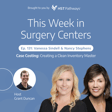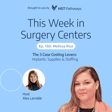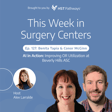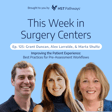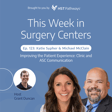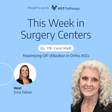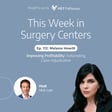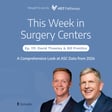Podcast Introduction
00:00:01
Speaker
Welcome to This Week in Surgery Centers. If you're in the ASC industry, then you're in the right place.
Episode Format Overview
00:00:07
Speaker
Every week, we'll start the episode off by sharing an interesting conversation we had with our featured guest.
00:00:12
Speaker
And then we'll close the episode by recapping the latest news impacting surgery centers. We're excited to share with you what we have. So let's get started and see what the industry's been up to.
00:00:28
Speaker
Hi everyone. Here's what you can expect on today's episode.
Josh Rudd's Surgery Center Journey
00:00:32
Speaker
Josh Rudd recently opened Knoxville Spine Surgery Center, his first time opening a brand new facility.
00:00:38
Speaker
So I sat down with Josh to hear what the process was really like from the initial idea all the way to their very first procedure. The conversation is packed with insights and whether you're planning a new build or just curious about what goes into launching an ASC from scratch,
00:00:53
Speaker
I think you'll find it both interesting and educational.
State of the Industry Report
00:00:56
Speaker
After my conversation with Josh, we'll switch to our data and insights segment. HST released our annual State of the Industry report in September, which analyzed client data from 590 surgery centers.
00:01:08
Speaker
Today, we'll spend a few minutes breaking down expected versus actual OR start times and tips for keeping your schedule on track. I hope everyone enjoys the episode, and here's what's going on this week in surgery centers.
Interview: Josh Rudd on New Surgery Center
00:01:24
Speaker
Hi, Josh. Welcome to the podcast. Hi, thanks for having me. I'm super excited to be sitting down with you today. We have done a bunch of episodes covering the kind of step-by-step process of opening a new surgery center, but obviously hearing it firsthand from someone who has recently and successfully gone through the process as always even better. So let's get right into it. Can you please tell us a little bit about yourself first and then about your new facility?
00:01:54
Speaker
Sure. My name is Josh Rudd. I'm with the practice administrator and administrator of a surgery center. So we've got a, we're a neurosurgery practice here in Knoxville that has 12 neurosurgeons and three pain guys.
00:02:07
Speaker
And we created a we built a surgery center in the we got a certificate of occupancy in August of 2024. And so I've been going through the great process of going through CMS and what and accreditation.
00:02:22
Speaker
And finally started hitting our stride a little bit.
00:02:27
Speaker
Very nice. And how many ORs do you have and what specialties? So our surgery center has four ORs, three procedure rooms, and we it's purely neurosurgery. So it's all one practice that is is the only practice that operates at the surgery center.
00:02:44
Speaker
So all of the referrals and everything is internal related to the pain. And so it's all self-contained. into the neurosurgery practice that kind of does it's all in the surgery center.
Motivations Behind Opening a New Center
00:02:57
Speaker
So what key indicators told you that it was the right time to open a new surgery center? That's a good question. So one of the the biggest prompts for us, we've been talking about it for several years, and the two biggest prompts for us were were with the number of physicians that we had. We felt like we had enough physicians to cover, to have a consistent flow of operations.
00:03:22
Speaker
And then really one of the big kickers was COVID. When COVID It happened. We, and like a lot of people, have worked on constraints of how much surgery we could do and where and when and all that. And with the size of the practice that we had, we decided we really needed to have some of that control on our own.
00:03:41
Speaker
And it really emphasized some of the other problems. concerns we've had in the past of if we, if one of our hospital partners dropped us in contract or whatnot, where would we operate and things like that. And so it just really brings it into something that we can control a little better and have a little more throughput. And then also just some control in the mechanisms of if something catastrophic goes wrong, and we have some ways of, we can still continue business.
00:04:11
Speaker
Sure. So once you made that decision, where did you begin? What were your first steps?
Planning and Construction Challenges
00:04:19
Speaker
Oh, well, that was a long process. So we we started the process back in probably 2021. with Tennessee, it's a set certificate of need state, which...
00:04:32
Speaker
causes a few different hurdles in the process, but mainly is you have to go through to a state-organized hearing and explain why you need the operating rooms and the and the space and basically justify the certificate.
00:04:48
Speaker
In Tennessee, we were, what's the word, advised, I guess, that the best way to do that would be to have a hospital partner. And so trying to figure out a hospital partner and how we might operate, might might work with that,
00:04:59
Speaker
and And then trying to figure out all the details of where we were going to place the surgery center. and they And so that that took a little while to work through. And as we all know, hospitals don't run at a very fast pace for anything. And so just the the slowness of the hospital to get through all of those hurdles really took quite a while. So that was from like 2021 to 2021.
00:05:21
Speaker
twenty twenty one to twenty twenty two was ah is at least a full year of planning and trying to figure out where to place this. And then and then it was getting to a floor plan and a budget. And there's just a whole lot of, it it takes quite a few years really to get to that point.
00:05:43
Speaker
And so, yeah, it took us quite a while. Sure.
Overcoming Financial Hurdles
00:05:47
Speaker
And did you have any moments going through that where you thought, wow, we're really in over our heads?
00:05:55
Speaker
Actually, several times. I still do, actually. But but no, yet just the sheer volume of the money that you're talking about is can be overwhelming. we Like I said, we started construction in 2021. Started building.
00:06:10
Speaker
started bidding in 2021, 2022. So cost was rising exponentially with a construction cost and with the certain parts of the build out, you had long timelines. And so we had to commit to get the process started. And some of the equipment was extremely expensive generators and the SPD equipment and everything that goes into it outside of just the normal construction process was it's a lot of money.
00:06:43
Speaker
And that's where you start. That's where I started filming overwhelmed and started wondering, okay, wait, are we making some mistakes? Can we cover this? And it it does get overwhelming. Sure. Yeah, I can imagine.
00:06:54
Speaker
While we're on the topic, was there, I'm just going ask you all the juicy questions here. Was there anything you ended up going over budget on that wish you put more money aside in hindsight?
00:07:07
Speaker
Really the main thing we, the generator, we went over money on generator, but a lot of that was supply and demand. It was that we had to have the generator and we needed it at a certain timeline. And so we had to pay a little extra to get it expedited and whatnot. And we did also go over on SPD equipment. We spent probably a little more on SPD for building for the future, as opposed to what we currently needed, because we had a really good consultant that
00:07:43
Speaker
has helped us through the process and he advised us that's not something that you want to have to try to retrofit later and build bring in more equipment later. It was, it's a lot easier to do it upfront, lot more cost efficient to do it upfront. And then you're not shutting down to operations to get a new cart washer or whatever it might be into the operation. And so we did go ahead and basically plan for all four ORs in operation for s SPD, even though for the first foreseeable two to five years, probably will be in two ORs. And so we really built out more than we had to.
Creating an In-house Anesthesia Group
00:08:22
Speaker
And okay, switching gears a little bit, because we are constantly talking about anesthesia staffing shortages, and I know that is top of mind. And there are surgery centers that have closed because of anesthesia shortages. There are people who are hesitant to open a new facility because of these issues.
00:08:39
Speaker
So how did you decide on your anesthesia model and what was that process like? ah Well, it's interesting process because we were forced into it. So we It's one of those things that you can plan for as much as you want, but certain things happen and you end up in a different boat than you expected. So we had a a letter of intent with a local anesthesia group to provide coverage.
00:09:04
Speaker
And four months before we were expected to get our certificate of occupancy, they backed out on the agreement. So we were left completely trying from it. We were completely at back at the start and trying to figure out how we were going to do this.
00:09:19
Speaker
So after going through different interviews and trying to figure out what other groups could possibly do it, we actually made the decision to start our own practice. So we created another, created an anesthesia group And we're able to locate a local physician that has been incredible for us to start with. Been a great partner because we've had a back and forth a relationship with anesthesia.
00:09:48
Speaker
And so that was always our concern is if we have an issue and a hospital has an issue, who's going to get the resource? And obviously it's going to be the hospital. And so having our own allowed us to know that We get first priority because it's our practice.
00:10:04
Speaker
The other part of that is that there's a lot more liability. And so now we're trying to figure out the business side of the anesthesia, which has been also pretty daunting. Yeah, I can imagine.
00:10:15
Speaker
So how many anesthesiologists are part of this group the group you created? Currently, we have one one DO o and two CRNAs. We're working through trying to figure out the PRN situation because we've only had the CRNA since January and February. So, so we're still trying to get through having enough PRN coverage to, to cover sicknesses and vacations and whatever might pop up.
00:10:45
Speaker
But right now that is, that's our current model. Yeah, I think that's super interesting. And obviously, and we always talk about people getting creative, but that's a huge undertaking. The same time you're opening up a surgery center, you're also opening up an anesthesia group. So I'm sure there was a lot of learnings that went along with that.
00:11:04
Speaker
There is, yes. But it did give us the ability to to, one thing it did help us with a lot, and I meant to mention earlier, was it gave us consistent staff, which we thought was a huge advantage to know it's the same CRNAs day in and day out.
00:11:20
Speaker
They know how our physicians will operate and how we flow and get used to the software. It's not a group that's rotating in and out CRNAs as needed or who's available. It gives us a very consistent staff from day to day.
Technology and EMR Decisions
00:11:36
Speaker
So when did you start bringing in technology? So like EMRs, scheduling, billing, and how did you prioritize those decisions?
00:11:46
Speaker
So we brought in the EMR fairly early as we started interviewing different software packages, of software providers. And i started visiting different local, well, a couple of local ASCs, but also trying to find other neurosurgery ASCs and what providers they used and who's been happy and just talking with people that weren't necessarily the software salespeople trying to figure out who was happy with... You get the real story at that point as to who's happy with their software and who's who's had complications and issues. And so that we started that, I'd say, fairly early in the process and took our time to decide.
00:12:28
Speaker
The physicians weren't really all that involved in the process. They didn't... At least the physicians I work with felt pretty... neutral on any software. They're like, well, we'll learn it. And so they didn't really have a ah big say. who we did focus in on where we had we worked into a billing group and we zeroed in on a group that we were going to use as a billing partner.
00:12:53
Speaker
And so we took their advice as to who to use. And then also we had some, we worked through the the workflows with the, with the director of nursing and some of the staff that we knew would be in the practice or at the surgery center and worked through the workflow to see how that would work with, with the staff that's using it day to day and see which one they liked. And that's how we ended up deciding.
00:13:18
Speaker
Yeah, I think that's a great. use Yeah. i love that you, so when you performed your first surgery, you obviously already had all of that stuff in place. Staff was trained, super users were identified, all that good stuff.
00:13:35
Speaker
Yeah, so we, soft, our practice has always, has been on an electronic EHR from since 2017. And so a paper EHR was never ah consideration for us. We were immediately wanted to go to an electronic and just start from there so that we didn't have to convert at some point in time in the near future.
00:13:56
Speaker
And so, yes, from day one, we had electronic EMR up and running. Gotcha. Very cool. So looking back, is there anything you would have done differently?
Accreditation Process Challenges
00:14:09
Speaker
Oh, man. In general, would have worked through some things. There's always a lot of little things that popped up that you're like, I didn't know that was going to take so long related to like CMS and how to get it going. And the accreditation, prepping for the accreditation took a lot longer than I anticipated.
00:14:27
Speaker
are To his credit, our consultant kept beating on me. And to be honest, I just didn't think it was going to take as long as he but he said, and it took every minute as long as he said it was going to take.
00:14:39
Speaker
But just getting the policies and procedures and all of the the backup documentation that goes into accreditation just took a lot longer than we anticipated. so we moved we had certificate of occupancy in august of twenty twenty four and we were not ready for accreditation until really late October was probably the first time we could have done a accreditation visit.
00:15:06
Speaker
But then we were just waiting for accreditation at that point.
00:15:12
Speaker
I gotcha. Yeah, makes sense.
Importance of Physician Buy-in
00:15:15
Speaker
All right, Josh, we do this every week with our guests. What is one thing our listeners can do this week to improve their surgery centers?
00:15:25
Speaker
So i think probably the but one thing that I would that keeps our surgery center and continues to be as successful starting as it has been was the complete buy in from the physicians.
00:15:39
Speaker
So all of the physicians have ownership in the surgery center. So they're all the hook for the money. And so that makes them all very adept at trying to make it work. Even if they're not happy with the software or instrument or whatnot, everybody's in the same boat on trying to make it profitable and start getting back to even. And so it's a it's got everybody focused on one mission. And so that that has been one of the biggest advantages i think our practice our surgery center has over most is just the complete buy-in from all of the physicians because they're all investors.
00:16:19
Speaker
Perfect. thank Thank you so much for coming on today. We really appreciate it. Thank you. Thanks for having me.
Improving Surgery Start Times with HSC Pathways Report
00:16:33
Speaker
HSC Pathways released an updated version of our State of the Industry Report in September, highlighting best practices, key process steps, and KPIs for every step of the patient journey and for nearly every recurring administrative duty.
00:16:45
Speaker
Most importantly, using our own unique dataset from our clients, we were able to extract data points so that anyone in the industry can compare themselves to their peers. Two quick disclaimers, we only pulled data from clients who gave us permission and we omitted any extreme outliers.
00:17:00
Speaker
So today, let's zero in on a metric that often flies under the radar but really shouldn't. On-time surgery starts. So according to HSC's 2024 State of the Industry data, surgeries are delayed by an average of 15.4 minutes.
00:17:15
Speaker
And while that might not sound like much, it does really add up fast. A 15-minute delay in the morning can trigger a chain reaction of bottlenecks, hurting ah OR utilization, pushing back recovery times, increasing staff overtime, and lowering patient satisfaction.
00:17:31
Speaker
Here's what stood out in the data. General surgery saw the highest average delay at 27.2 minutes. Cardiovascular and pain procedures weren't far behind with delays over 19 minutes.
00:17:44
Speaker
And then on the other end of the spectrum, ENT, gynecology, and urology had the shortest delays, all three averaging under 10 minutes. Now, in this full State of the Industry report, we did break this out even further by 12 different specialties.
00:17:58
Speaker
So if you're looking for a specialty I didn't just mention, head to the episode notes, find the link to the report, and you can find that data point along with many others. So what can ASCs do to improve?
00:18:09
Speaker
Let's focus on four tricks that are within your control. Tip number one is to incentivize punctuality. Consider creating a recognition or bonus program tied to on-time starts.
00:18:21
Speaker
Even awarding the department with the most first case on-time starts can go a long way towards building a culture of accountability. Tip number two, streamline those pre-op processes.
00:18:32
Speaker
So delays often stem from incomplete documentation, missing pre-clearance or equipment not being prepared. So you want to automate what you can, especially around patient readiness checks and documentation to avoid any pre-preventable holdups.
00:18:48
Speaker
Tip number three is to enforce those first case on-time start policies, or if you don't have one, create one. The first case really sets the tone for the rest of the day.
00:18:59
Speaker
If the first case starts late, the whole day really gets thrown off. So some centers even cancel a first case if it's running more than 15 minutes late, which might sound a little harsh, but it is certainly one way to protect the rest of the schedule.
00:19:13
Speaker
And lastly, tip number four is to track and share those on-time start metrics. So regularly track which providers or procedures are frequently delayed. And this really isn't meant to be punitive. It's just about transparency.
00:19:27
Speaker
So when teams can see the data, they're more likely to adjust to their behavior. So you can share those metrics in an end-of-month recap email. You can post them in your break room. I also strongly suggest you share them in your quarterly board meetings as well.
00:19:41
Speaker
And if you're not already tracking this, the formula is really simple. Just take your scheduled OR start time minus to the actual OR start time, and then take the average, and that is your baseline.
00:19:53
Speaker
So to sum it up, a few minutes here or there might not feel urgent, but over the course of a week or a month, these delays can cost your ASE both time and money, so just don't let it become the norm. If you're interested in more data points and use cases, head to our website to check out the full State of the Industry report to get your hands on even more data.
00:20:13
Speaker
And that officially wraps up this week's podcast. Thank you, as always, for spending a few minutes of your week with us. Make sure to subscribe or leave a review on whichever platform you're listening from. i hope you have a great day, and we will see you again next week.

